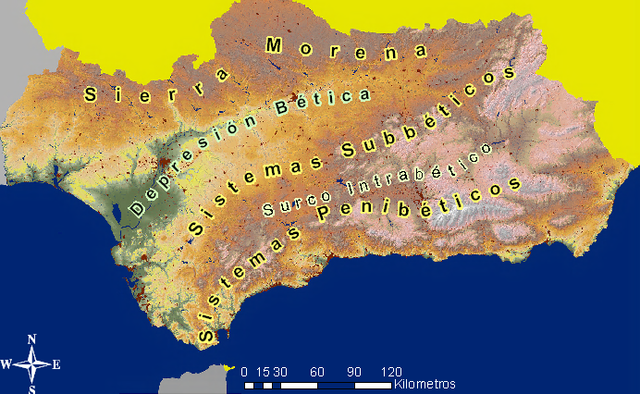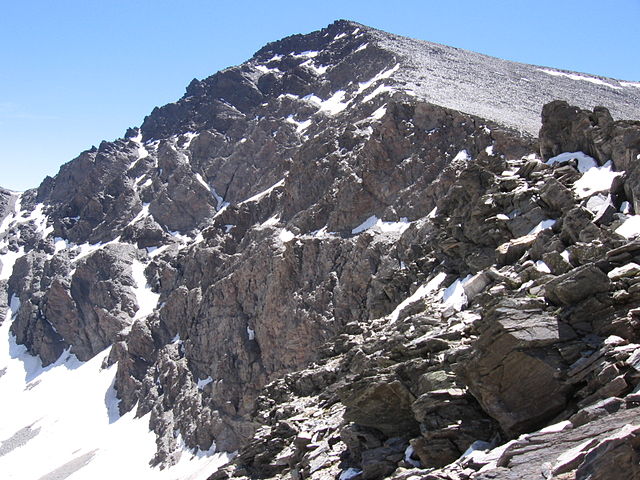Andalusia
autonomous community of Spain From Wikipedia, the free encyclopedia
Andalusia (Spanish: Andalucía) is the first in population among the 17 Autonomous communities in Spain and the second in area. The territory is divided into eight provinces: Almería, Cádiz, Córdoba, Granada, Huelva, Jaén, Málaga and Seville. Its capital is the city of Seville (Spanish: Sevilla).
Andalusia
| |
|---|---|
Autonomous community | |
|
| |
| Motto(s): Andalucía por sí, para España y la Humanidad[1] ("Andalusia by itself, for Spain and humanity") | |
| Anthem: "La bandera blanca y verde" "The White and Green flag" | |
 Map of Spain with Andalusia highlighted | |
| Coordinates: 37°23′N 5°59′W | |
| Country | |
| Statute of Autonomy | 28 February 1980 / 18 February 2007 (current version) |
| Capital (and largest city) | Seville |
| Provinces | Almería, Cádiz, Córdoba, Jaén, Málaga, Granada, Huelva, Seville |
| Government | |
| • Type | Devolved government in a constitutional monarchy |
| • Body | Council of Andalusia |
| • President | Juan Manuel Moreno (PP-A) |
| • Vice President | Juan Marín (Cs) |
| Legislature | Parliament of Andalusia |
| National representation | Parliament of Spain |
| Congress seats | 61 of 350 (17.4%) |
| Senate seats | 41 of 265 (15.5%) |
| Area (17.2% of Spain) | |
| • Total | 87,268 km2 (33,694 sq mi) |
| • Rank | 2nd |
| 17.2% of Spain | |
| Population (2016) | |
| • Total | 8,388,107 |
| • Rank | 1st |
| Demonym(s) | Andalusian andaluz, -za[2] |
| Official languages | Spanish |
| GDP | |
| • Rank | 17th |
| • Total (2019) | €110.9 billion |
| • Per capita | €19.107 (17th) |
| HDI | |
| • HDI (2019) | 0.873 (very high · 14th) |
| Time zone | CET (UTC+1) |
| • Summer (DST) | CEST (UTC+2) |
| ISO 3166 code | ES-AN |
| Telephone code(s) | +34 95 |
| Currency | Euro (€) |
| Official holiday | February 28 |
| Website | www |
Andalusia is in the south of the Iberian peninsula, just to the south of the autonomous communities of Extremadura and Castile-La Mancha; west of the autonomous community of Murcia and the Mediterranean Sea; east of Portugal and the Atlantic Ocean; and north of the Mediterranean Sea and the Strait of Gibraltar. The small British Overseas Territory of Gibraltar shares a land border with the Andalusian province of Cádiz at the eastern end of the Strait of Gibraltar.
History
The name Andalusia is the modern version of the Arabic language Al-Andalus (الأندلس), name used by the Muslim Moors for all of the territory of the Iberian Peninsula under their control. During that period, northern Iberian Peninsula was controlled by Christian kings and the southern Iberian Peninsula was controlled by Moors.
In 711 CE, the Moors invaded the Iberian Peninsula, then controlled by Christians of Visigothic origin. By 719 the Moors conquered all of the peninsula except for a small area in the northern Pyrenees Mountains. The Moors used the name Al-Andalus for all of the territory of the Iberian Peninsula under their control.
Christians in the north waged war for more than seven centuries against the Moors, gradually taking over more and more of the southern areas. This process of war is called the Reconquista (a Spanish and Portuguese word meaning "to conquest again"). In the year 1492 under Spanish Inquisition, King Ferdinand and Queen Isabella of Spain retook the last stronghold in the southern area at Granada. In that same year, the majority Muslim Moors and Sephardi Jews were forced to leave Spain, other who want stay in Andalusia got baptized and became Catholic Christians.
Symbols
The Andalusian coat of arms shows the figure of Hercules and two lions between the two pillars of Hercules that tradition puts on both sides of the Strait of Gibraltar. The words below read Andalucía por sí, para España y la Humanidad ("Andalusia by herself, for Spain and Humanity"). Over the two columns is an arch in the colors of the flag of Andalusia, with the Latin words Dominator Hercules Fundator.[1]
The official flag of Andalusia has three equal horizontal stripes, colored green, white, and green respectively; the Andalusian coat of arms is on the central stripe. It was approved in a meeting in 1918 of Andalusian nationalists at Ronda, a city in the province of Málaga.[1]
The anthem of Andalusia was composed by José del Castillo Díaz with lyrics by Blas Infante. The music was inspired by Santo Dios, a religious folk song sung at harvest time by peasants.[1]
The national holiday, the Día de Andalucía, is celebrated on 28 February.
Geography
Andalusia is one of the 17 Spanish autonomous communities and is in the southwestern region of the European Union.[3] It has a surface area of 87,597 square kilometres (33,821 sq mi), 17.3 percent of the territory of Spain. By area, it is the second Spanish autonomous community.
The natural limits of Andalusia are: to the south, the Atlantic Ocean and the Mediterranean Sea; to the north, the Sierra Morena, mountain range that separates Andalusia from the autonomous communities of Extremadura and Castilla-La Mancha; to the west is Portugal; and to the east is Murcia.[3]
Relief


Andalusia has the Iberian peninsula's highest mountains and nearly 15 percent of its terrain over 1,000 metres (3,300 ft). The picture is similar for areas under 100 metres (330 ft) (with the Baetic Depression), and for the variety of slopes.
The Atlantic coast is mostly beach and gradually sloping coasts; the Mediterranean coast has many cliffs.[4] These differences divide the region naturally into Upper Andalusia (two mountainous areas) and Lower Andalusia (the broad basin of the Guadalquivir).[5]
The three main geographical regions of Andalusia are:
- The Sierra Morena separates Andalusia from the plains of Extremadura and Castile–La Mancha on Spain's Meseta Central. Although few people live there, this is not a particularly high range.
- The Baetic Cordillera consists of the parallel mountain ranges of the Cordillera Penibética near the Mediterranean coast and the Cordillera Subbética to the north. The Cordillera Subbética is quite discontinuous, offering many passes that facilitate transportation, but the Penibético forms a strong barrier between the Mediterranean coast and the interior. The Sierra Nevada, part of the Cordillera Penibética in the Province of Granada, has the highest peaks in the Iberian peninsula: Mulhacén at 3,481 metres (11,421 ft) and Veleta at 3,324 metres (10,906 ft).[6]
- Lower Andalusia or valley of the Guadalquivir is between these two mountainous areas. It is a nearly flat territory, open to the Atlantic Ocean in the southeast. Throughout history, this has been the part of Andalusia where there are more people.
Climate

In general, Andalusia has a Mediterranean climate, except in the Valley of Granada (Spanish: Vega de Granada), with occasional heavy rains and extremely hot temperatures.
Rainfall decreases from west to east. The place in Andalusia with the highest rainfall is in the Sierra de Grazalema (2,138 millimetres (84.2 in) per year) and the driest place is Cabo de Gata, the place with the least amount of rainfall in Europe with only 117 millimetres (4.6 in) of rain per year.
The average temperature in Andalusia throughout the year is over 16 °C (61 °F). Averages in the cities range from 15.1 °C (59.2 °F) in Baeza to 18.5 °C (65.3 °F) in Málaga.[7] Much of the Guadalquivir valley and the Mediterranean coast has an average of about 18 °C (64 °F). The coldest month is January when Granada at the foot of the Sierra Nevada experiences an average temperature of 6.4 °C (43.5 °F). The hottest are July and August, with an average temperature of 28.5 °C (83.3 °F) for Andalusia as a whole. Córdoba is the hottest provincial capital, followed by Seville.

The mountain ranges are cooler than the plains and have a higher rainfall with some snow in winter. The Sierra Nevada, above 3,000 m (9,843 ft), is snow covered for most of the year.[8]
Rivers
Andalusia has rivers that flow into both the Atlantic and the Mediterranean. Flowing to the Atlantic are the Guadiana, Odiel-Tinto, Guadalquivir, Guadalete, and Barbate. Flowing to the Mediterranean are the Guadiaro, Guadalhorce, Guadalmedina, Guadalfeo, Andarax (also known as the Almería) and Almanzora. Of these, the Guadalquivir is the longest in Andalusia and fifth longest on the Iberian peninsula, at 657 kilometres (408 mi).[9]
Administrative divisions
Andalusia consists of eight provinces. Each of the Andalusian provinces bears the same name as its capital:[10]

People
The Andalusians are the inhabitants of Andalusia of the southern region in Iberian Peninsula. Traditional male Circumcision is usually performed due to Islamic influence, especially in the Province of Granada.[12] They are generally considered an ethnically distinct peoples because of the two of the most important markers of distinctiveness: their own language and an awareness of a presumed common origin. Andalusian is said to be a distinct dialect of Spanish, according to the Andalusian nationalism. The Andalusians have a rich culture which includes the famous flamenco style of music and dance, even though it was adopted by the Spanish Caló who have changed it and monopolized into their own culture.
References
Other websites
Wikiwand in your browser!
Seamless Wikipedia browsing. On steroids.
Every time you click a link to Wikipedia, Wiktionary or Wikiquote in your browser's search results, it will show the modern Wikiwand interface.
Wikiwand extension is a five stars, simple, with minimum permission required to keep your browsing private, safe and transparent.









